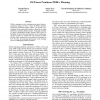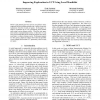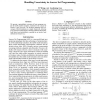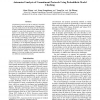AAAI
2015
8 years 8 months ago
2015
Human computation or crowdsourcing involves joint inference of the ground-truth-answers and the workerabilities by optimizing an objective function, for instance, by maximizing th...
AAAI
2015
8 years 8 months ago
2015
In many learning tasks with structural properties, structural sparsity methods help induce sparse models, usually leading to better interpretability and higher generalization perf...
AAAI
2015
8 years 8 months ago
2015
PDDL+ planning involves reasoning about mixed discretecontinuous change over time. Nearly all PDDL+ planners assume that continuous change is linear. We present a new technique th...
AAAI
2015
2015
SCRAM: Scalable Collision-avoiding Role Assignment with Minimal-Makespan for Formational Positioning
8 years 8 months ago
Teams of mobile robots often need to divide up subtasks efficiently. In spatial domains, a key criterion for doing so may depend on distances between robots and the subtasks’ l...
AAAI
2015
8 years 8 months ago
2015
Monte Carlo planning has been proven successful in many sequential decision-making settings, but it suffers from poor exploration when the rewards are sparse. In this paper, we im...
AAAI
2015
8 years 8 months ago
2015
Automatic citation recommendation can be very useful for authoring a paper and is an AI-complete problem due to the challenge of bridging the semantic gap between citation context...
AAAI
2015
8 years 8 months ago
2015
We present a probabilistic extension of logic programs under the stable model semantics, inspired by the concept of Markov Logic Networks. The proposed language takes advantage of...
AAAI
2015
8 years 8 months ago
2015
Commitment protocols provide an effective formalism for the regulation of agent interaction. Although existing work mainly focus on the design-time development of static commitmen...
AAAI
2015
8 years 8 months ago
2015
Operator cost partitioning is a well-known technique to make admissible heuristics additive by distributing the operator costs among individual heuristics. Planning tasks are usua...
AAAI
2015
8 years 8 months ago
2015
Latent author attribute prediction in social media provides a novel set of conditions for the construction of supervised classification models. With individual authors as trainin...




